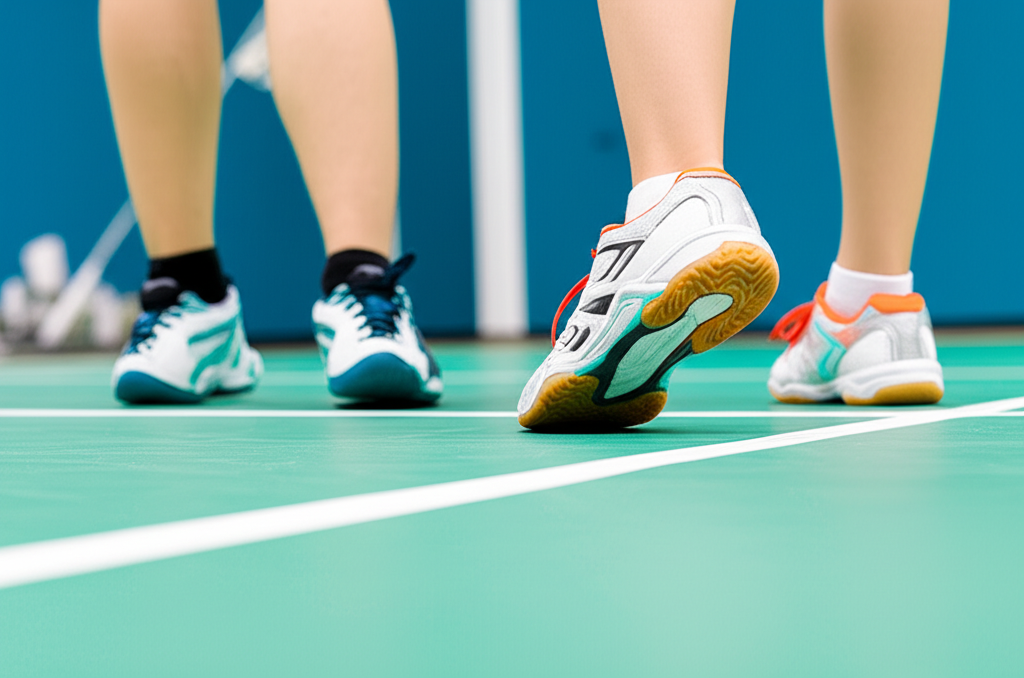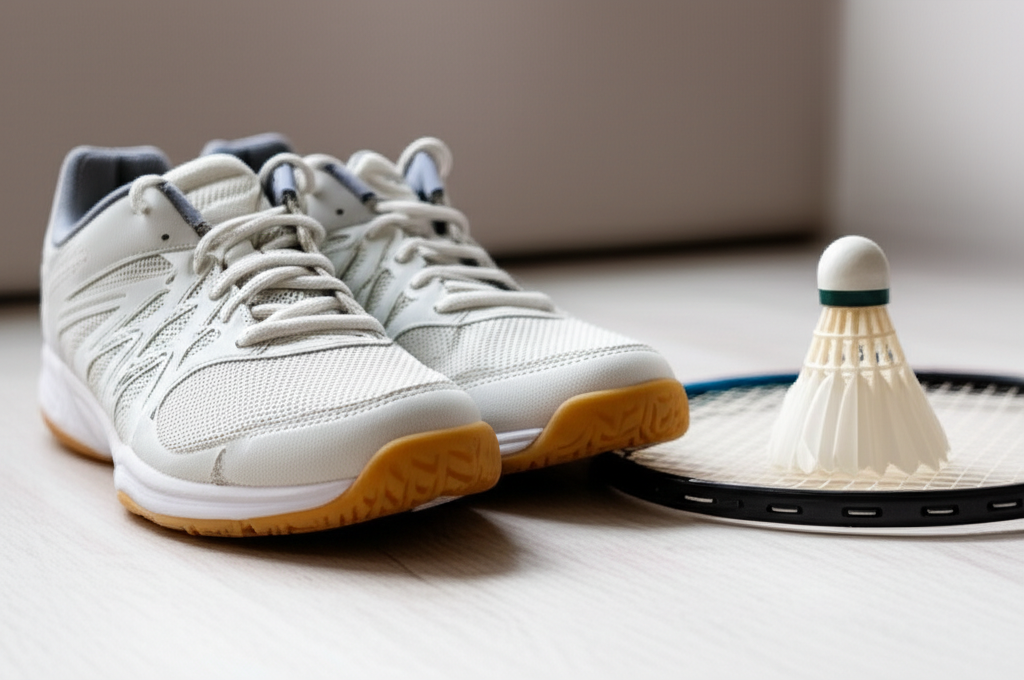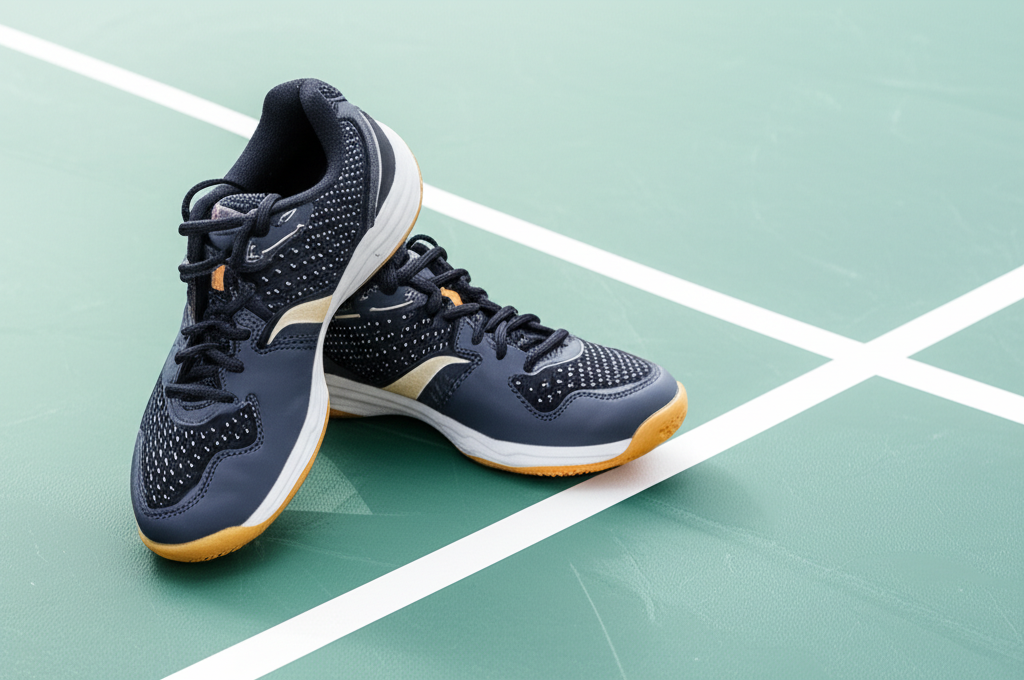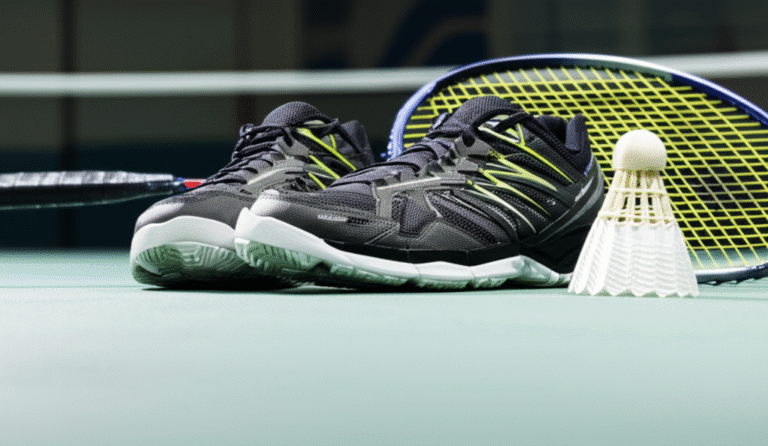Can Walking Shoes Be Used For Badminton? The Shocking Truth Revealed!
Can walking shoes be used for badminton? While they might seem similar, using walking shoes for badminton is generally not recommended due to differences in support, traction, and sole design, which can increase injury risk. Badminton requires specific footwear for quick, multi-directional movements.
Key Takeaways
- Badminton needs specialized court shoes.
- Walking shoes lack lateral support for quick stops.
- Badminton shoes offer superior grip on courts.
- Impact absorption differs significantly.
- Wearing walking shoes risks ankle sprains and falls.
- Invest in proper badminton shoes for safety and performance.
Stepping onto a badminton court for the first time can be exciting! You’ve got your racket, you’re ready to play, but what about your shoes? It’s a common question for beginners: “Can walking shoes be used for badminton?” Many people think that since both involve being on your feet, any comfortable athletic shoe will do. This is a natural thought, but the reality is quite different and potentially surprising. Understanding the specific demands of badminton will help you see why your trusty walking shoes might not be the best choice. Let’s uncover the truth and ensure you’re stepping onto the court safely and effectively.
Understanding the Demands of Badminton

Badminton isn’t just about walking; it’s a dynamic sport. Players constantly perform a variety of movements that put unique stresses on their feet and ankles. Think about it: you’re lunging forward to reach a shuttlecock, jumping to smash, and rapidly changing direction to cover the court. These actions require a shoe that can handle rapid acceleration, sudden stops, and lateral (sideways) movements. The court surface itself, often a wooden or synthetic material, also plays a role in the type of footwear needed.
The speed of the game is immense. Professional badminton players can serve the shuttlecock at speeds exceeding 300 miles per hour! While you might not be playing at that level, even recreational play involves quick reflexes and movements. Your feet need to be prepared for this intense activity. Without the right support, you’re not just hindering your performance; you’re putting yourself at a higher risk of injury.
Walking Shoes: Designed for Pavement, Not Play
Walking shoes are designed with a specific purpose in mind: comfortable, sustained walking on relatively flat and stable surfaces like sidewalks, pavements, or trails. Their construction focuses on cushioning for shock absorption during forward motion and providing arch support for prolonged periods of standing or walking. They typically have a more flexible sole that bends easily with your foot.
The cushioning in walking shoes is often concentrated in the heel and forefoot to absorb the impact of each step. They also tend to have a durable outsole for wear resistance on various outdoor terrains. However, this flexibility and forward-focused cushioning are precisely what make them less suitable for the multi-directional, stop-and-go nature of sports like badminton.
Key Features of Walking Shoes
- Cushioning: Primarily designed for impact absorption during forward walking.
- Flexibility: Soles are typically more flexible to mimic the natural foot motion during walking.
- Support: Focuses on arch support and stability for sustained walking.
- Traction: Outsoles are made for general grip on common walking surfaces.
- Weight: Often lighter for comfort during long walks.
While these features are excellent for their intended use, they fall short when it comes to the demands of a sport like badminton. The “shocking truth” is that what feels comfortable for a stroll can become a hazard on the court.
Badminton Shoes: Engineered for the Court

Badminton shoes, also known as court shoes, are meticulously engineered for the specific movements and environment of the game. They are built to provide stability, traction, and support during quick, explosive movements and sudden stops. The design prioritizes preventing injuries that can occur from the lateral stress and rapid directional changes characteristic of badminton.
Unlike walking shoes, badminton shoes offer enhanced lateral support. This means they are designed to prevent your foot from rolling inwards or outwards excessively when you make quick side-to-side movements. The soles are also crucial. They are made with specific rubber compounds and tread patterns to maximize grip on indoor court surfaces, allowing for swift starts and stops without slipping.
Essential Features of Badminton Shoes
- Lateral Stability: Reinforced sides and upper to support side-to-side movements.
- Non-Marking Soles: Made of special rubber that grips the court without leaving scuff marks.
- Cushioning (Strategic): Designed to absorb shock from jumping and landing, often with specific impact zones.
- Durability: Built to withstand the abrasion and stress of court play.
- Fit: Often a snugger fit to prevent foot slippage inside the shoe.
- Lightweight: While supportive, they are still designed to be agile.
These features work together to create a shoe that allows you to play your best while minimizing the risk of common badminton injuries. Let’s break down why walking shoes just don’t measure up in these critical areas.
Why Walking Shoes Fall Short for Badminton
The fundamental difference lies in the types of forces your feet experience during walking versus playing badminton. Walking is largely a linear motion, with your foot striking the ground and rolling forward. Badminton involves a complex interplay of linear, lateral, and rotational movements, often happening simultaneously.
1. Lack of Lateral Support
This is arguably the biggest issue. When you play badminton, you’ll be moving side-to-side frequently, lunging, and recovering. Walking shoes are generally not built with robust lateral support. Their uppers are often softer and less reinforced on the sides. This means that when you push off sideways or try to stop abruptly, your foot can roll over the edge of the sole, leading to ankle instability and a high risk of sprains.
Badminton shoes, on the other hand, have reinforced side panels and a wider base that provides a stable platform. This prevents excessive pronation (rolling inward) or supination (rolling outward) during these crucial movements.
2. Insufficient Traction
Court surfaces for badminton are typically smooth and can become slippery, especially with sweat. Walking shoes usually have deeper treads designed for grip on varied outdoor surfaces like grass, dirt, or asphalt. While this provides good traction for walking, it can be problematic on a polished court. The deeper lugs might not engage effectively with the smooth surface, leading to slipping. Worse, the rubber compound in walking shoe soles might not be designed for the specific friction needed for controlled stops and pivots on a sports court.
Badminton shoes use special non-marking rubber compounds with specific tread patterns. These are engineered to offer optimal grip on indoor courts, allowing you to change direction sharply without losing your footing. A good grip is essential for both performance and preventing falls.
3. Inadequate Shock Absorption for Dynamic Movements
While walking shoes have cushioning, it’s optimized for the repetitive impact of walking. Badminton involves a lot more jumping and landing from various heights, as well as forceful stops. The cushioning in walking shoes might not be sufficient to absorb the higher impact forces generated by these dynamic movements. This can lead to foot fatigue, shin splints, and even stress fractures over time. Badminton shoes often feature more advanced cushioning technologies placed strategically to handle the specific stresses of jumping and landing.
4. Sole Flexibility and Design
Walking shoe soles are often quite flexible, bending easily in the middle. This is great for a natural walking gait. However, for badminton, you need a shoe that offers more torsional stability (resistance to twisting) and a sole that supports your foot during explosive movements. A highly flexible sole can allow your foot to twist unnaturally during quick changes in direction, increasing the risk of injury.
Badminton shoes typically have a firmer sole with targeted flexibility, offering a balance between support and the ability to move naturally on the court. The sole is also often flatter to provide a larger contact area with the ground, enhancing stability.
A Comparison Table: Walking Shoes vs. Badminton Shoes

To visualize the differences, let’s look at a direct comparison:
| Feature | Walking Shoes | Badminton Shoes |
|---|---|---|
| Primary Purpose | Comfortable walking on stable surfaces | Agility and support for court sports |
| Lateral Support | Limited; prone to ankle rolling | Excellent; reinforced sides for stability |
| Traction | General grip for varied terrains; can slip on courts | High grip for court surfaces; non-marking |
| Cushioning | Optimized for forward impact | Strategic for jumping, landing, and stops |
| Sole Flexibility | High; bends easily | Moderate; balanced with torsional stability |
| Durability | Good for walking wear | High for court abrasion and stress |
| Injury Risk (for Badminton) | Higher (sprains, falls) | Lower |
As you can see from the table, the design philosophies are entirely different, catering to distinct physical demands. Relying on walking shoes for badminton is akin to using a screwdriver as a hammer – it might technically do something, but it’s not the right tool for the job and can lead to problems.
What Happens When You Wear Walking Shoes for Badminton?
The immediate consequences of wearing walking shoes on a badminton court can range from minor inconveniences to serious injuries. You might notice that you feel less stable, particularly when trying to move quickly or change direction. You might slip more often, leading to a loss of confidence and control during rallies. Your feet might also feel more tired or sore after a game than they would after a walk.
The more serious risks include:
- Ankle Sprains: The most common injury. Lack of lateral support allows the ankle to roll outwards or inwards excessively during quick movements, stretching or tearing ligaments.
- Falls and Collisions: Poor traction increases the likelihood of slipping, which can lead to falls. Falls can result in bruises, fractures, or collisions with other players or court equipment.
- Knee and Hip Pain: The increased instability and impact forces can put undue stress on your knees and hips as your body tries to compensate for the inadequate footwear.
- Foot Pain: Inadequate support and cushioning for the specific stresses of badminton can lead to general foot pain, plantar fasciitis, or even stress fractures over time.
For anyone interested in improving their posture and overall comfort through the right footwear choices, understanding these risks is paramount. Wearing the wrong shoes can counteract any positive effects you hope to achieve from physical activity.
Choosing the Right Badminton Shoes: A Beginner’s Guide
Now that you know why walking shoes aren’t ideal, let’s talk about finding the right badminton shoes. Don’t be intimidated; it’s simpler than you think.
1. Fit is King
This is the most important factor for any shoe. Your badminton shoes should fit snugly but not be too tight. There should be about a thumb’s width of space between your longest toe and the front of the shoe. Your heel should feel secure and not slip up and down when you walk or move. Try shoes on at the end of the day when your feet are slightly swollen, and wear the type of socks you’d typically use for playing.
2. Look for Badminton-Specific Features
As discussed, prioritize shoes designed for court sports. Look for:
- Lateral support: Check if the sides of the shoe feel firm and supportive.
- Good grip: The sole should feel sticky and designed for smooth indoor surfaces. Ensure it’s non-marking.
- Cushioning: Feel for adequate padding, especially in the heel and forefoot, to absorb impact.
- Torsional rigidity: The shoe shouldn’t twist too easily in the middle.
3. Consider the Court Surface
Most indoor badminton courts are made of wood or synthetic materials. Shoes designed for these surfaces will have the appropriate grip. If you happen to play on a different surface (less common for badminton), you might need to research specific shoe types, but for standard indoor courts, general badminton shoes are suitable.
4. Brands and Models
Many reputable sports brands offer excellent badminton shoes. Popular choices include Yonex, Li-Ning, Victor, and Adidas. Don’t be afraid to try on different brands and models to see what feels best for your feet. Many beginner-friendly models offer a great balance of support, comfort, and affordability.
5. Price Point
You don’t need to break the bank for your first pair of badminton shoes. Decent beginner to intermediate shoes can range from $60 to $120. Investing in proper footwear is crucial for your safety and enjoyment of the sport.
For more detailed information on shoe anatomy and how it impacts performance, resources like those from the National Institutes of Health (NIH) can offer insights into biomechanics and injury prevention related to footwear.
Can I Use Running Shoes for Badminton?
This is another common question. Running shoes are also designed for a specific purpose: forward motion with significant shock absorption for the repetitive impact of running. They are typically lightweight and have excellent cushioning, especially in the heel.
However, like walking shoes, running shoes lack the crucial lateral support needed for badminton. Their soles are often designed with different tread patterns and flexibility that might not provide optimal grip on a court. The cushioning is also geared towards the linear impact of running, not the multi-directional stresses of badminton. Therefore, running shoes are also generally not recommended for playing badminton, for many of the same reasons walking shoes are unsuitable.
| Sport | Ideal Shoe Type | Why Walking/Running Shoes Aren’t Ideal |
|---|---|---|
| Walking | Walking Shoes | N/A (designed for this purpose) |
| Running | Running Shoes | N/A (designed for this purpose) |
| Badminton | Badminton Court Shoes | Lack lateral support, proper court traction, and suitable impact absorption for dynamic movements. |
| Tennis | Tennis Court Shoes | Similar needs to badminton (lateral support, court grip), though tennis shoes can be heavier and have different sole patterns depending on court type (clay vs. hard). |
| Basketball | Basketball Court Shoes | High ankle support, excellent grip, and robust cushioning for jumping and landing. |
The key takeaway is that each sport’s unique demands necessitate specialized footwear. Trying to use shoes designed for one activity in another can compromise safety and performance.
Pro Tips for Badminton Footwear
Pro Tip: Always keep your badminton shoes for indoor court use only. This preserves their grip and prevents dirt and debris from being tracked onto the court, which can cause slipping. Avoid wearing them for walking or running errands.
Frequently Asked Questions (FAQs)
Q1: Will I get injured if I wear walking shoes for badminton?
You significantly increase your risk of ankle sprains, falls, and other lower body injuries when wearing walking shoes for badminton due to their lack of lateral support and inadequate court traction.
Q2: Are all “court shoes” the same? Can I use tennis shoes for badminton?
While tennis shoes are also court shoes and offer more support than walking shoes, they are designed for the specific movements and court surfaces of tennis, which can differ from badminton. Badminton shoes are generally lighter and more flexible, tailored to badminton’s agile play. It’s best to use shoes specifically designed for badminton for optimal safety and performance.
Q3: How often should I replace my badminton shoes?
This depends on how often you play and the intensity of your games. For regular players, it’s recommended to inspect your shoes every 6-12 months. Look for signs of wear on the sole, cushioning that has lost its bounce, or damage to the upper. Replacing them before they are completely worn out is key to preventing injuries.
Q4: What is the difference between non-marking soles and regular soles?
Non-marking soles are made of special rubber compounds that provide excellent grip on indoor courts without leaving black scuff marks. Regular soles might use different materials or tread patterns that can leave marks on polished court surfaces, potentially damaging them and reducing grip.
Q5: My feet get sore after playing badminton. Could it be my shoes?
Yes, foot soreness can definitely be a sign that your shoes aren’t providing adequate support or cushioning for the demands of badminton. Wearing shoes not designed for the sport, or even worn-out specialized shoes, can lead to fatigue and pain. Investing in a good pair of badminton shoes with proper fit and support is often the solution.
Q6: Can I wear my everyday sneakers for badminton?
Everyday sneakers, like casual fashion sneakers, generally offer even less support and traction than walking shoes. They are typically not designed for athletic activity and should not be used for playing badminton, as they pose a significant risk of injury.
Conclusion
The “shocking truth” about using walking shoes for badminton is that they are fundamentally unsuited for the sport. While they offer comfort for strolling, they lack the critical lateral support, specialized traction, and impact absorption necessary for the dynamic, multi-directional movements of badminton. Wearing them can lead to slips, falls, and serious injuries like ankle sprains. The best way to protect yourself, enhance your performance, and truly enjoy the game is by investing in a pair of shoes specifically designed for badminton. Your feet, ankles, and knees will thank you for it, allowing you to focus on your game with confidence and agility.

